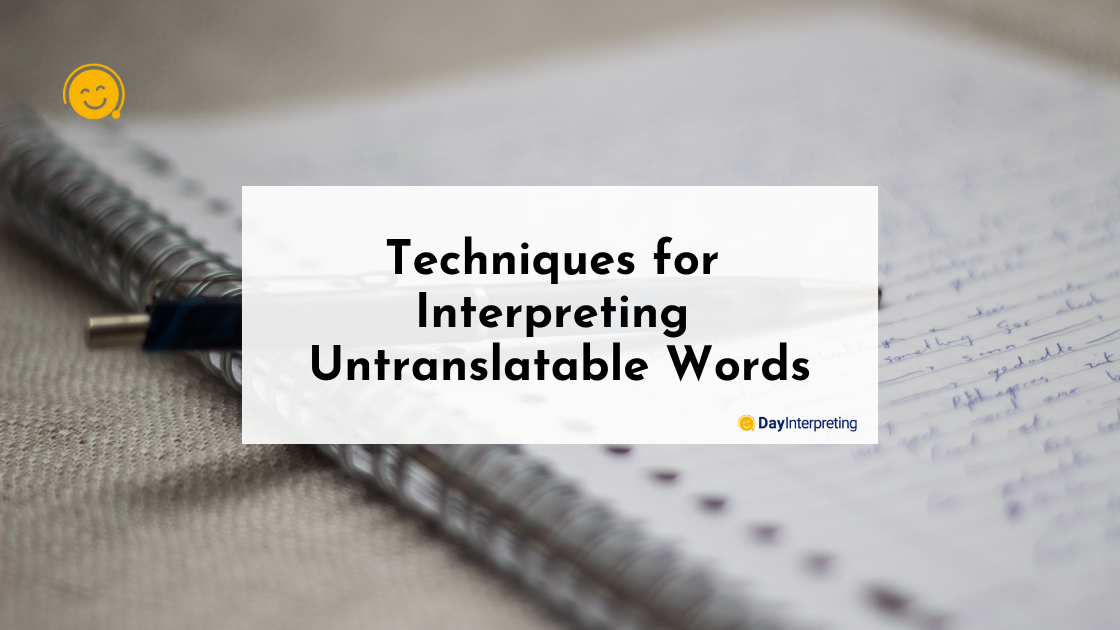If you’ve ever tried to speak with someone from another country using Google Translate, you’ll eventually come across some pretty funny translations. In some situations, it’s easy to laugh it off and rephrase the sentence until the meaning is understood. However, there are many times when interpreters need to communicate critical information quickly. And that brings us to the matter of interpreting untranslatable words.
For example, in:
- Business meetings
- Emergency rooms
- Press conferences
An interpreter must use the proper techniques to keep the conversation or dialog flowing during these times.
In this post, you’ll find six of the most popular techniques for interpreting untranslatable words.
1. Compensation
Interpreters use compensation when they can’t translate the nuance of a dialog correctly.
For example, in English, there is only one way to use the word ‘you.’ However, the French language has tu (informal) and vous (formal).
Similarly, Korean has many honorific nouns, pronouns, and titles that people use depending on who they talk to or talk about. In Korea, they use 집 (jip – informal) or 댁 (daek – formal), to refer to a house depending on who they are talking to or talking about. For example, Koreans would use daek if referring to their grandparents’ house.
However, in English, using house or home is standard no matter who’s involved in the conversation. While English does have formal alternatives for those words, they don’t show higher levels of respect—only formality.
To compensate for these untranslatable words, interpreters will often make specific word choices during the interpretation to increase the respect of the dialog.
2. Target Language Adaptation
Interpreters use adaptation when encountering specific cultural references that aren’t directly translatable. That’s why some interpreters may refer to adaptation as cultural substitution instead.
However, adaptation only works well if the concept fits the target language.
For example, say an interpreter was in a business meeting discussing an upcoming Black Friday sales event. If the interpreter were to translate this literally, it wouldn’t make much sense to the listener unless they were familiar with the shopping tradition.
For someone unfamiliar with the event, the interpreter may liken it to:
- Singles Day or Chinese New Year in China
- Diwali in India
- El Buen Fin in Mexico
By adapting Black Friday into a more relevant event for the listener, they can better convey the concept.
3. Circumlocution or Neutralization of Other Languages
When the adaptation of untranslatable words is too tricky, an interpreter will likely use circumlocution. While circumlocution sounds complicated, it simply means explaining the word or idea in other languages.
Interpreters often use this technique for words that relate to complex ideas, as they can be challenging to translate. For example, the Finnish word sisu, used to describe the country’s national character, combines many different traits into a single word. It’s not always the easiest of tasks to summarize this in the English language.
Sisu encompasses determination, bravery, resilience, and more into one word. But breaking the word into separate traits will likely confuse the target. Instead, interpreters may describe it as “never giving up despite facing a seemingly impossible task,” or “having the determination to face situations that are more difficult than usual.”
Another example of neutralization comes from a German word, schadenfreude. If an interpreter were to translate this word literally, they would end up with the combination of “harm/joy.” However, the word’s true meaning relates to “enjoying the suffering of others.”
Neutralization is an essential technique for interpreters as many situations don’t let them prepare for untranslatable words.
3. Calque or Literal Translation
Like the schadenfreude example above, literal translation doesn’t always get the job done.
However, calque does have its place when interpreting scientific or technical topics. For example, if interpreters need to translate a cutting-edge technology solution in a shareholder meeting.
Outside of technical topics, literal or direct translation can create plenty of confusion. For example, if you were to calque the German word krankenwagen, you’d end up with “sick car” in English.
With this definition, some people may think the car is somehow broken. However, the correct translation and exact meaning is ambulance. In this case, translating words literally doesn’t render the same meaning.
While literal translation does have its uses, it isn’t the typical technique that professional interpreters use.
4. Borrowing
Borrowing typically happens when a word is well-known globally—for example, corporate words like meeting and software. However, interpreters also borrow foreign words if there is no other way to translate the same word in a particular language.
Interpreters often borrow words that relate to foods and cultures as these are usually specific to a language. If an interpreter talked about the Spanish tradition of holding a quinceañera on a girl’s 15th birthday, they’d likely include the word in the translation as it has cultural significance. Loanwords are generally understood in more than one language and are used when it’s appropriate for the target culture.
Many borrowed words have even become part of the English language, for example:
- Cafe (French)
- Kimono (Japanese)
- Kimchi (Korean)
- Loot (Hindi)
- Cigar (Spanish)
5. Reformulation
Reformulation helps different speakers communicate and understand idioms, proverbs, and other complex sentences that don’t translate well. While reformulation may seem similar to adaptation, there are some key differences. Adaptation makes the language more culturally appropriate, e.g., substituting a quinceañera for a sweet sixteenth, even though the meaning isn’t entirely the same.
On the other hand, reformulation maintains the meaning of the original sentence by using an equivalent idiom in the target language. For example, a German idiom, “Die Katze im Sack kaufen,” literally translates to, “to buy a cat in a sack.” However, the true meaning refers to buying something without inspecting it, which in English would be, “buy a pig in a poke (bag).” Another example comes from the French saying, “Les carottes sont cuites!” Which translates to, “The carrots are cooked!” However, in this case, the speaker refers to the idiom equivalent of “What’s done is done.” In English.
Ensure Your Linguist Knows the Art of Interpreting Untranslatable Words
Languages are complex, and many nuances are lost in translation. So if you plan to hire an interpreter for a crucial situation, make sure that they’re aware of the techniques for interpreting untranslatable words. And, of course, make sure they’re an expert in the languages that they’ll be interpreting. After all, no interpreting technique will work if your interpreter doesn’t understand each language inside and out.
At Day Interpreting, we ensure that every one of our interpreters are experts before they’re matched with you. Whether you need a web, phone, or in-person interpreter, you can rest assured knowing that the process will run smoothly.





0 Comments